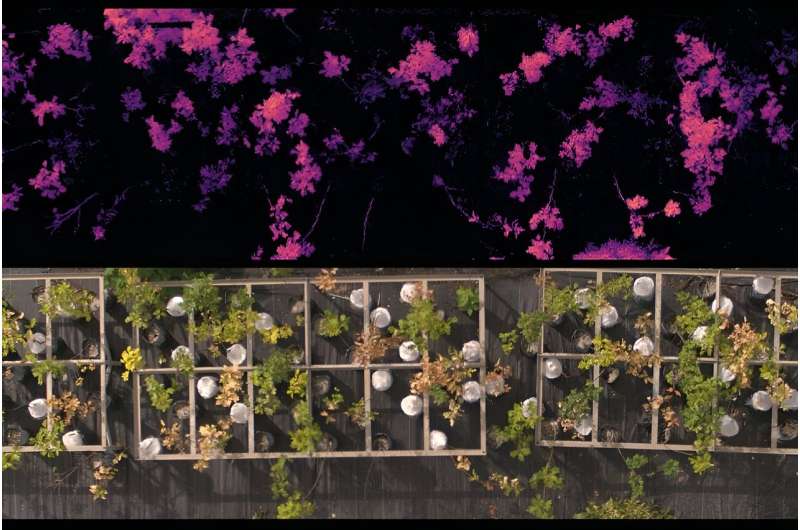This article has been reviewed according to Science X's editorial process and policies. Editors have highlighted the following attributes while ensuring the content's credibility:
fact-checked
trusted source
proofread
Innovative detection system allows researchers to differentiate oak wilt and drought

Oak forests play a vital role in our ecosystem, providing climate regulation and erosion control across North America. However, these forests face compounding threats from drought and oak wilt, and it can be challenging to tell these two issues apart.
Using an innovative approach that combines remote sensing tools with physiological measurements, University of Minnesota researchers have developed a way to detect oak wilt early and accurately—an essential step in safeguarding the health of oak-dominated forests.
Their newly published research in the Proceedings of the National Academy of Sciences demonstrates the ability to predict physiological processes related to oak wilt and drought stress from light reflected from canopies.
"Forest health specialists often comment on how difficult it is to distinguish between oaks dying from two-lined chestnut borer and drought impact versus oak wilt in the same forest stands. This research demonstrates the potential to detect and differentiate between these two critical oak problems," said Jennifer Juzwik, an adjunct associate professor in the University's College of Food, Agricultural and Natural Resource Sciences.
Using spectral ecophysiology, a novel integration of plant ecophysiology, and remote sensing for advanced plant stress monitoring, this approach enables early detection of oak wilt and drought. It combines biological insights with landscape measurement efficiency.
The researchers found that by analyzing spectral reflectance data, they could detect specific indicators like declines in photosynthetic efficiency and loss of leaf rehydration capacity up to two weeks before trees show visual signs of decline. They also discovered that the patterns of decline in the canopies mirror the patterns of blocked conduits in the stems, and these patterns are specific to each type of stress.
Further research based on this method could allow early detection of various threats to forest health.
"These models are like superhuman eyes—they see light at wavelengths far beyond what we can see. Once trained, they can use the information hidden in our eyes to translate light into physiology," said lead author Gerard Sapes, a biological scientist at the University of Florida, formerly a postdoctoral researcher at the University of Minnesota.
This breakthrough encourages further exploration of the intricate links between ecophysiology and spectral reflectance, paving the way for more nuanced plant stress assessment. This research is a significant stride toward efficient, widespread application of plant stress monitoring.
"The study provides an elegant integration of physiological methods and spectral biology to detect and differentiate drought effects and disease effects in young trees. We are now able to accurately predict disease development and drought in oaks," said Jeannine Cavender-Bares, director of the ASCEND Biology Integration Institute and a professor in the College of Biological Sciences.
Future research should explore broader applications of spectral ecophysiology to understand better what can and cannot be predicted from spectral reflectance. Scaling up the methodology to cover larger forested areas and diverse ecosystems would enhance its generalization ability, but doing so will bring new challenges requiring research-based solutions.
Collaborative efforts with forest management agencies and policymakers are crucial for integrating and scaling these innovative methods into real-world monitoring and management practices.
More information: Gerard Sapes et al, Mechanistic links between physiology and spectral reflectance enable previsual detection of oak wilt and drought stress, Proceedings of the National Academy of Sciences (2024). DOI: 10.1073/pnas.2316164121
Provided by University of Minnesota

















